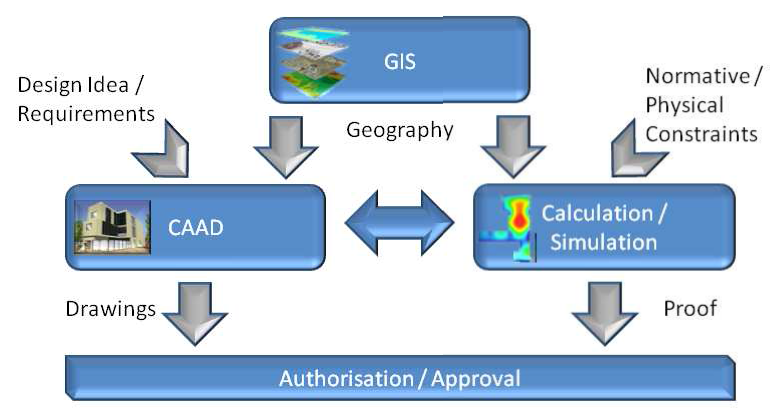Computers in building design
Contents |
[edit] Introduction
Today, the process of designing buildings is dominated by computers. Software tools used in the design phase can automate repetitive calculation and drawing tasks, help find new design solutions and provide a high degree of precision. This optimisation makes the design process faster, clearer and more effective.
The starting point for the use of computers in the construction industry was structural calculations. Civil engineer Konrad Zuse is considered to be one of the major pioneers in computer technologies. In 1941 he developed the world's first functional programme-controlled Turing-complete computer, the Z3. Structural calculations were followed by drawing tools and geographic information systems.
The origins of Computer Aided Design (CAD) lie in the aircraft industry in the 1960s. In the 1980s, these systems also made their break-through in architecture. Specialised Computer Aided Architectural Design (CAAD) software programmes started to improve the drawing process in 2D. In the 1990s, tools emerged which provided the possibility of 3D drawing and subsequently, object-oriented design systems were developed.
Today these tools can create, simulate and analyse construction alternatives for a wide range of purposes.
Design data produced by specific software tools is used throughout the life-cycle of a building – from project development through to refurbishment – and, in addition to architects and engineers, it is used by building owners, statutory authorities and contractors.
Essential input for the design phase is provided by location-related data, which is processed by Geographical Information Systems (GIS) tools. Design ideas are investigated with computer aided architecture tools (CAAD) and informed by calculation and simulation tools. This interdependence means that both data production and data communication are enormously important.
There is a broad choice of products for the design phase. Starting with simple sketch tools through to sophisticated building information modelling software.
[edit] Geographical Information Systems (GIS)
GIS systems support the design process through the preparation of information about the site and geography. Collected data can be summarised and is available for the designers in real-time. Direct interfaces of the applied GIS systems ensure that corresponding design tools are given access to this database.
[edit] Computer Aided Architectural Design (CAAD / CAD) and BIM
Design documents can be created by CAD tools in 2D, 2½D and 3D. 2D and 2½D designs can be used for standard building designs. 3D-software is needed for polyaxial curvatures, varying curves and dynamic structures. Drawing elements are vector-based such as points, lines, poly-lines, circles, etc. Textures simulate materials and depth. Complete building elements exist in specific libraries for the creation of models. These elements can be specified by various parameters.
Linking single elements of this database forms a connected model with interdependent parts, which means that changes to one part of the model can influence other parts if necessary. Elevation drawings, sectional views and 3D views can be generated as construction drawings. The design data from these software tools can be exported and imported using various exchange formats for further use.
Building Information Modelling (BIM) is a very broad term that describes the the process of creating a digital model of a building. The levels of this form of modelling are categorised as:
- Level 0: Unmanaged CAD.
- Level 1: Managed CAD in 2D or 3D.
- Level 2: Managed 3D environment with data attached, but created in separate discipline models.
- Level 3: Single, online, project model with construction sequencing, cost and lifecycle management information.
For more information see Building Information Modelling and Computer Aided Design.
[edit] Calculation and simulation
Calculation and simulation tools allow the dynamic behaviour of complex systems and processes to be modelled. Such tools supply a fact-based understanding of a design’s form and physics and, in doing so, sectoral planning in various dimensions are integrated. The same volumetric data model is integrated into different calculation and simulation tools. Often calculation and simulation software can be used as a plug-in tool for the specific CAAD software system, or interfaces may be used.
Progress made in software and hardware allows more and more applications for such tools in calculating and simulating different aspects of a building. Most important is structural optimisation through the finite element method (FEM) and the estimation of cost by quantity calculations. Furthermore, simulation and calculation tools are available for the purposes for illumination, acoustics, fire prevention, energy efficiency, ventilation, heating, and so on.
The text in this article is based on an extract from COMPUTER METHODS IN CONSTRUCTION, by Christoph Motzko, Florian Binder, Matthias Bergmann, Bogdan Zieliski, Mariusz Zabielski and Robert Gajewski. Darmstadt, Warsaw 2011. The original manual was developed within the scope of the LdV program, project number: 2009-1-PL1-LEO05-05016 entitled “Common Learning Outcomes for European Managers in Construction”. It is reproduced here in a slightly modified form with the kind permission of the Chartered Institute of Building.
--CIOB
[edit] Related articles on Designing Buildings Wiki.
- An algorithm in architecture.
- Building drawing software.
- Building information modelling.
- COBie.
- Computer aided design.
- Computers in tendering.
- Computers in the management of construction.
- Computational fluid dynamics.
- Computer numerical control.
- Connected procurement.
- Cyber security.
- Document control.
- Excel and construction.
- Generative design.
- Geographic information systems.
- Global positioning systems and global navigation satellite systems.
- Houzz Pro business software.
- Information and communications technology.
- Internet of things.
- Microchip.
- Real time.
- Smart buildings.
- What is design?
Featured articles and news
RTPI leader to become new CIOB Chief Executive Officer
Dr Victoria Hills MRTPI, FICE to take over after Caroline Gumble’s departure.
Social and affordable housing, a long term plan for delivery
The “Delivering a Decade of Renewal for Social and Affordable Housing” strategy sets out future path.
A change to adoptive architecture
Effects of global weather warming on architectural detailing, material choice and human interaction.
The proposed publicly owned and backed subsidiary of Homes England, to facilitate new homes.
How big is the problem and what can we do to mitigate the effects?
Overheating guidance and tools for building designers
A number of cool guides to help with the heat.
The UK's Modern Industrial Strategy: A 10 year plan
Previous consultation criticism, current key elements and general support with some persisting reservations.
Building Safety Regulator reforms
New roles, new staff and a new fast track service pave the way for a single construction regulator.
Architectural Technologist CPDs and Communications
CIAT CPD… and how you can do it!
Cooling centres and cool spaces
Managing extreme heat in cities by directing the public to places for heat stress relief and water sources.
Winter gardens: A brief history and warm variations
Extending the season with glass in different forms and terms.
Restoring Great Yarmouth's Winter Gardens
Transforming one of the least sustainable constructions imaginable.
Construction Skills Mission Board launch sector drive
Newly formed government and industry collaboration set strategy for recruiting an additional 100,000 construction workers a year.
New Architects Code comes into effect in September 2025
ARB Architects Code of Conduct and Practice available with ongoing consultation regarding guidance.
Welsh Skills Body (Medr) launches ambitious plan
The new skills body brings together funding and regulation of tertiary education and research for the devolved nation.
Paul Gandy FCIOB announced as next CIOB President
Former Tilbury Douglas CEO takes helm.
UK Infrastructure: A 10 Year Strategy. In brief with reactions
With the National Infrastructure and Service Transformation Authority (NISTA).

























Comments
To start a discussion about this article, click 'Add a comment' above and add your thoughts to this discussion page.